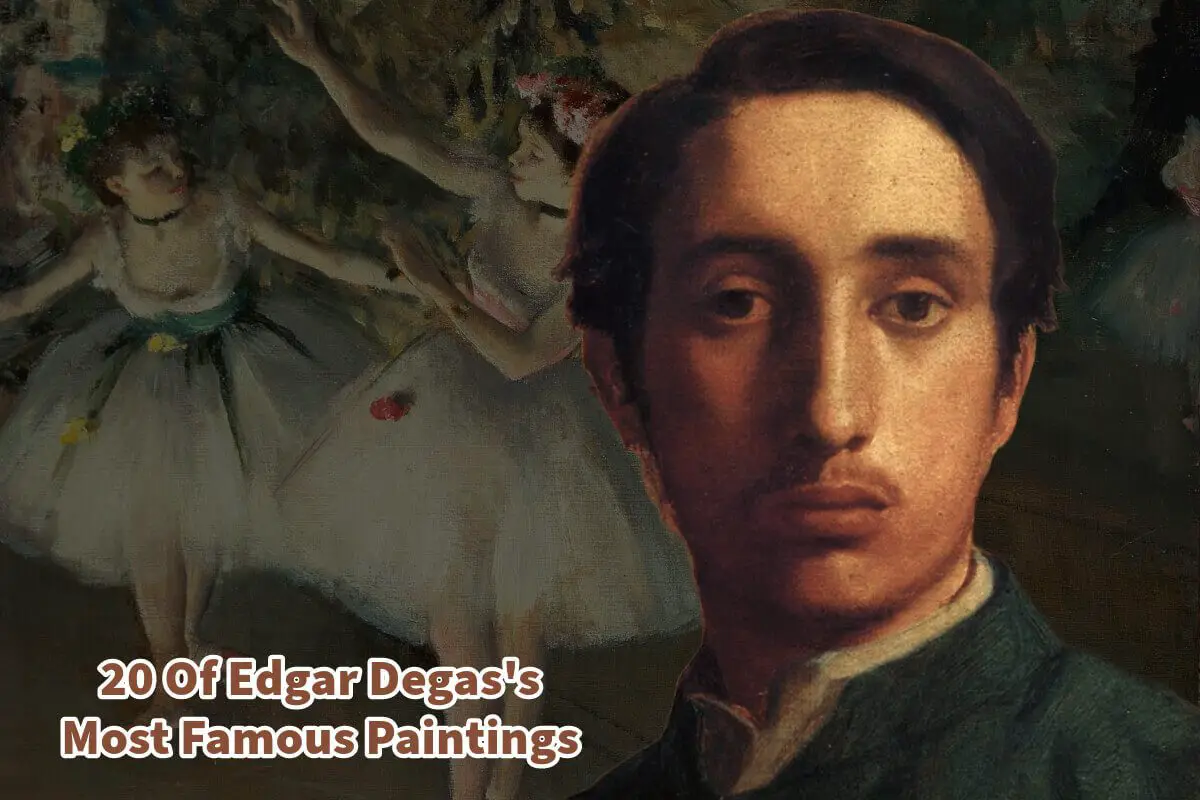Edgar Degas is one of the most influential artists to have ever lived. He has left us with a great collection of his works of art.
Edgar Degas (1834-1917) was a French artist famous for his paintings, sculptures, prints, and drawings. He is primarily known for his masterful depiction of movement, often focusing on dancers and innovative compositional techniques. Here is a look at 20 of his most famous paintings:
Table of Contents
- What Is Edgar Degas’ Most Important Painting? 20 Of Edgar Degas’ Most Important Paintings
- The Green Dancer (circa 1879)
- Place de la Concorde (1875)
- The Rehearsal of the Ballet Onstage (1874)
- Two Dancers in Yellow and Pink (circa 1890)
- Self Portrait (circa 1857)
- The Tub (1886)
- A Woman Ironing (circa 1873)
- The Ballet Class (1881)
- Portrait of Mary Cassatt (circa 1884)
- After the Bath, Woman Drying Herself (1890s)
- Blue Dancers (1899)
- L’Étoile (The Star) (1878)
- Two Dancers on Stage (1874)
- The Absinthe Drinker (1876)
- A Cotton Office in New Orleans (1873)
- The Dancing Class (1870)
- The Bellelli Family (1858-1867)
- The Dance Foyer at the Opera on the rue Le Peletier (1872)
- Woman Combing Her Hair (1888-1890)
- Orchestra Musicians (1872)
- Frequently Asked Questions
- Related Questions
What Is Edgar Degas’ Most Important Painting? 20 Of Edgar Degas’ Most Important Paintings
Edgar Degas was a prolific artist whose extensive work defies easy categorization or ranking. His contributions to the art world span several genres and mediums, making it difficult to pinpoint a small number of definitive masterpieces.
Yet, specific works stand out for their influence, innovative techniques, or unique perspectives. Here’s an exploration of 20 of his most important works and why they are considered so:
The Green Dancer (circa 1879)
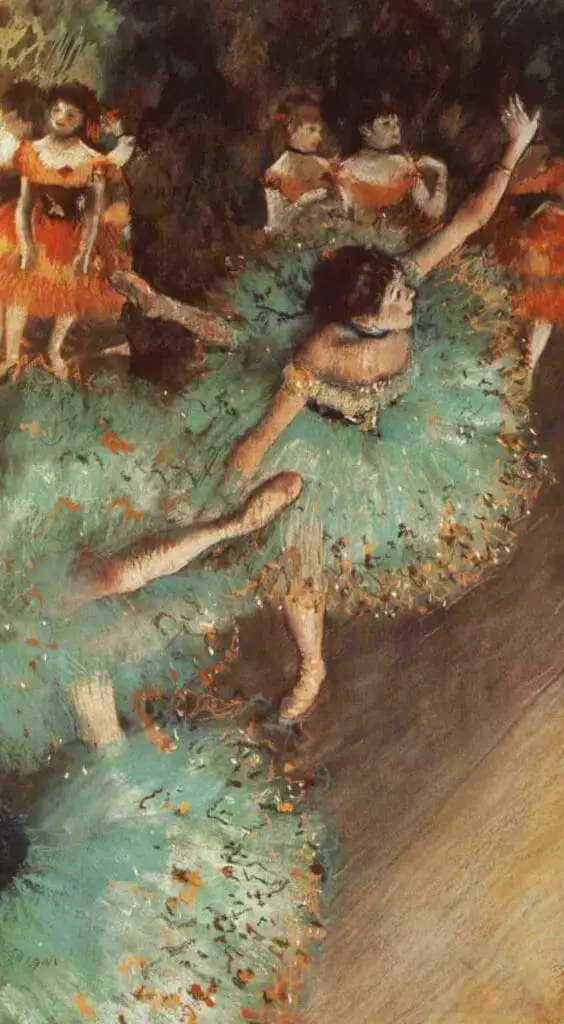
This painting is famous for its vibrant color and dynamic movement. The dancer is caught in a graceful position, allowing Degas to explore the qualities of light and color. The piece is a classic example of Degas’ interest in capturing motion.
Place de la Concorde (1875)
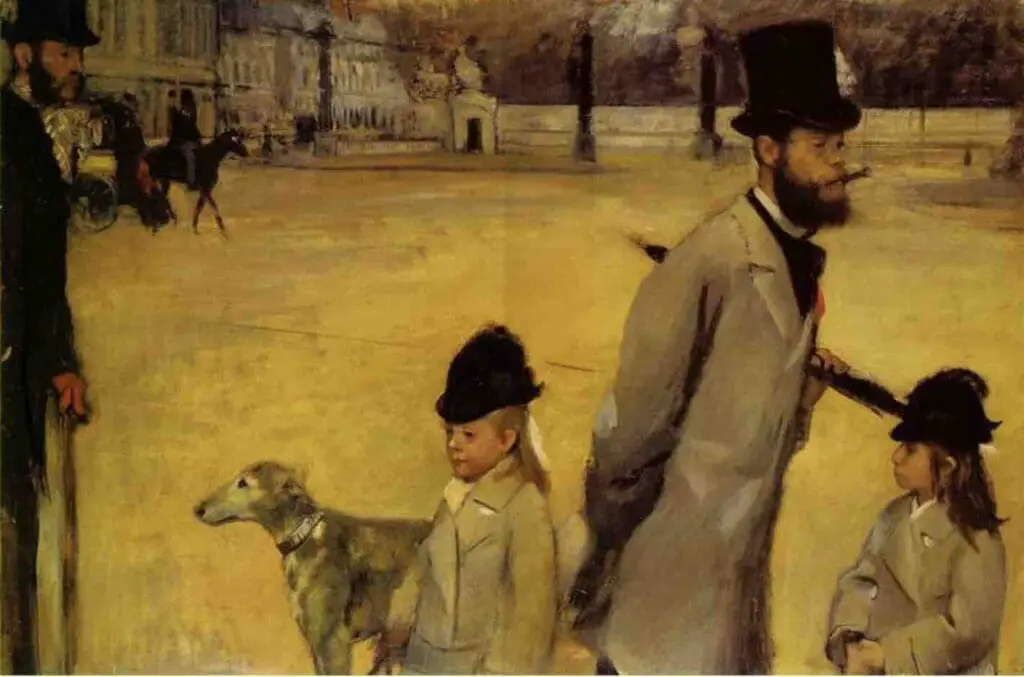
This painting features Viscount Lepic and his daughters crossing the Place de la Concorde in Paris. Known for its realistic depiction of everyday life, it’s a masterpiece of composition and perspective.
The Rehearsal of the Ballet Onstage (1874)
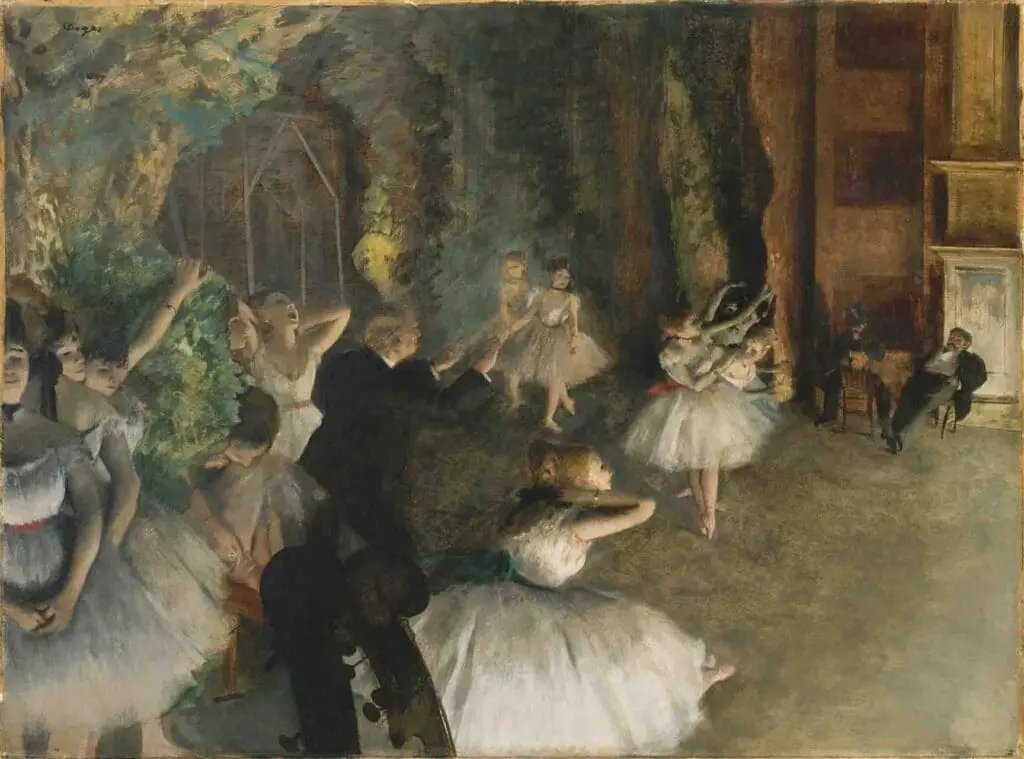
Degas captures the chaos and rigor of a ballet rehearsal. The angles and viewpoints are unconventional, embodying Degas’ mastery of composition.
Two Dancers in Yellow and Pink (circa 1890)
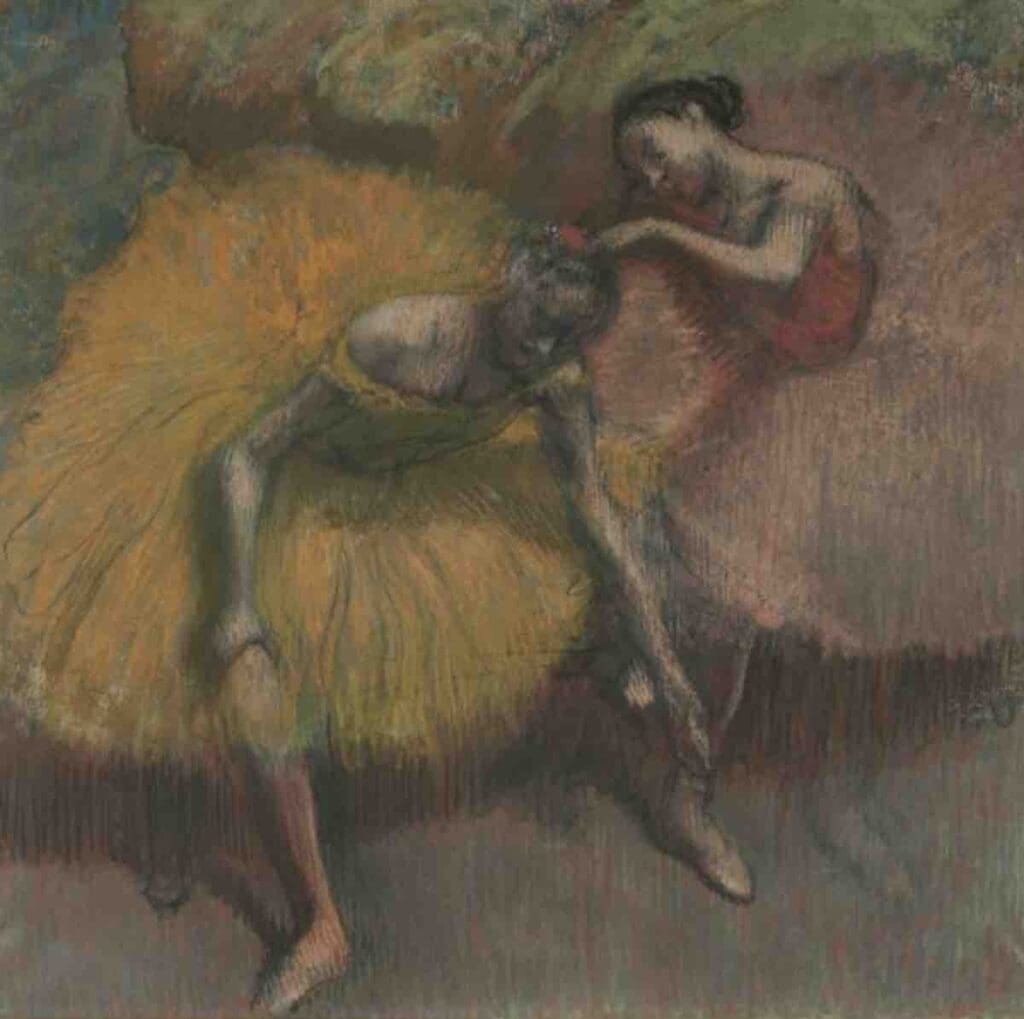
The focus is on the relationship between the dancers. Their harmonious postures and colors symbolize a moment of rest and contemplation amid the whirlwind of dance.
Self Portrait (circa 1857)

An early work where Degas explores his own identity, something uncommon in his later career, which focused more on the subjects around him.
The Tub (1886)

Here, Degas portrays a woman in her personal space. The angle is voyeuristic but poetic, showing Degas’ fascination with the female form and his mastery of capturing intimacy.
A Woman Ironing (circa 1873)

In this painting, Degas shows an ordinary woman performing a mundane task. His representation of the scene carries a sense of realism and empathy, focusing on the dignity of labor.
The Ballet Class (1881)
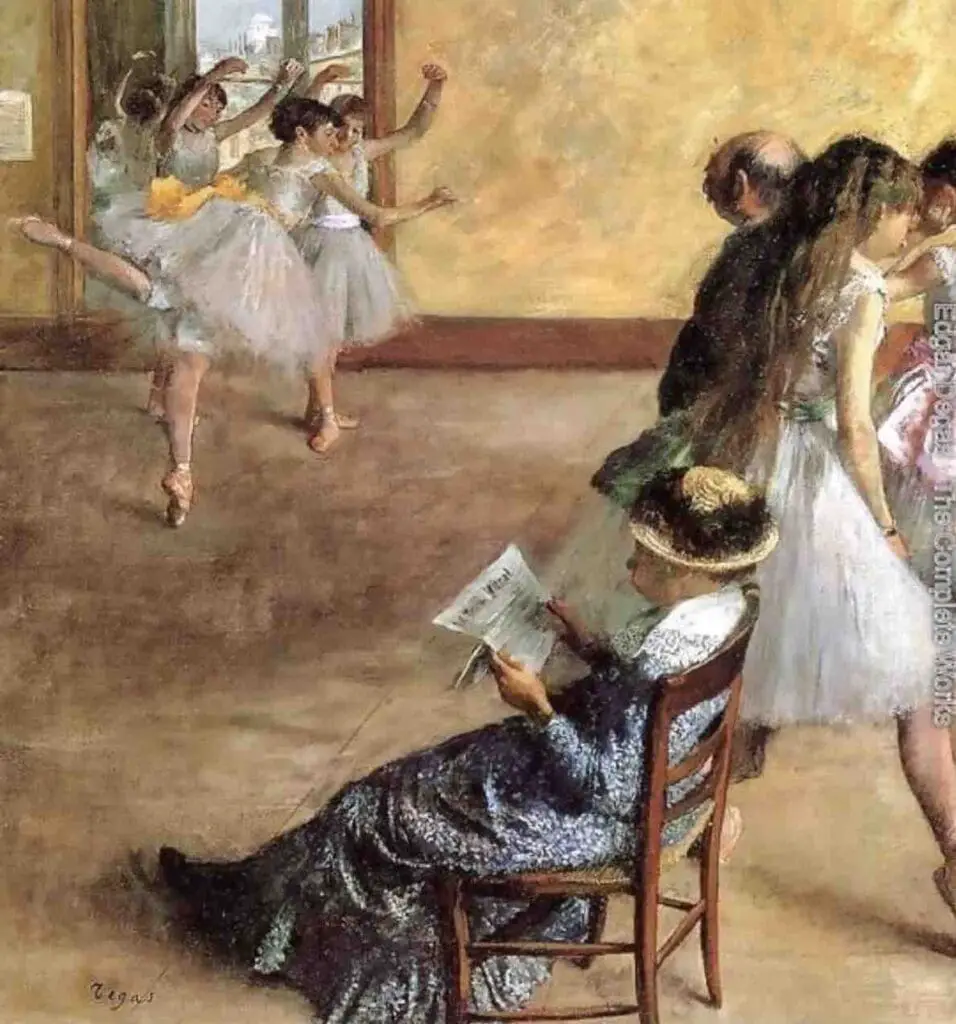
In this painting, Degas captures a ballet class in full swing, highlighting the exhaustion and discipline it requires. The background elements offer multiple viewpoints, a technique Degas often employed.
Portrait of Mary Cassatt (circa 1884)
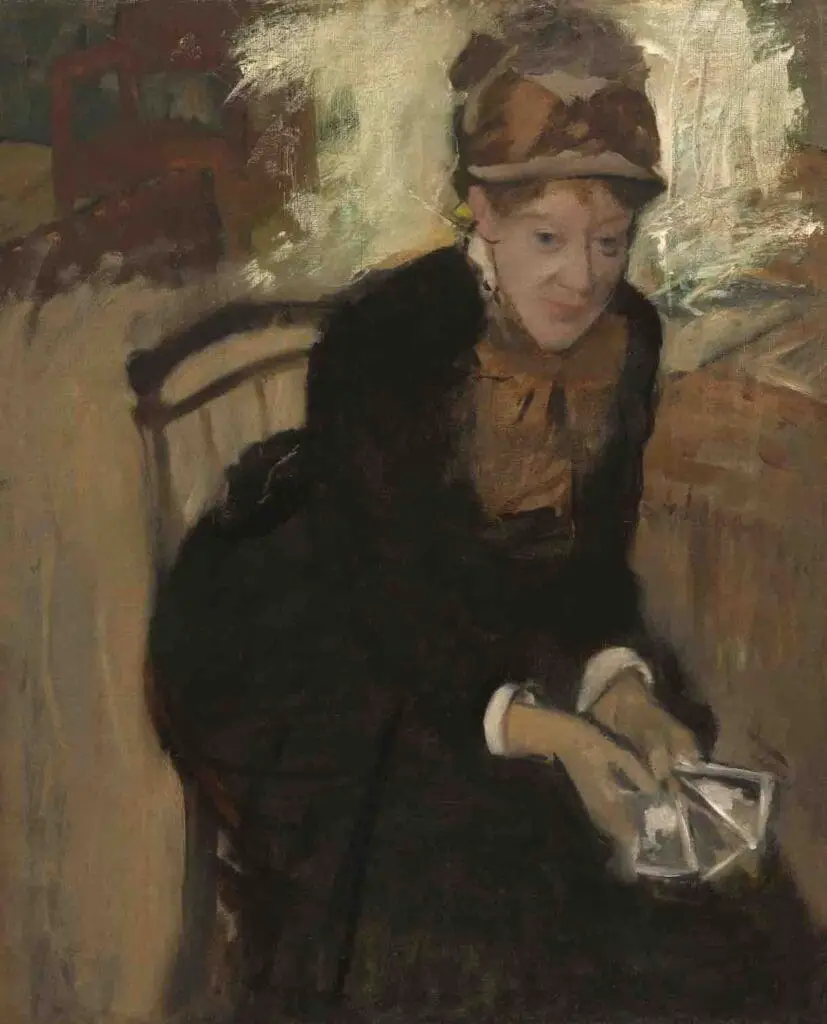
Mary Cassatt was an American painter and a close friend of Degas. The painting captures her in an elegant, contemplative mood, underlining their mutual artistic respect.
After the Bath, Woman Drying Herself (1890s)

This piece is part of a series depicting women in various stages of bathing, again highlighting Degas’ capacity to capture intimate moments.
Blue Dancers (1899)
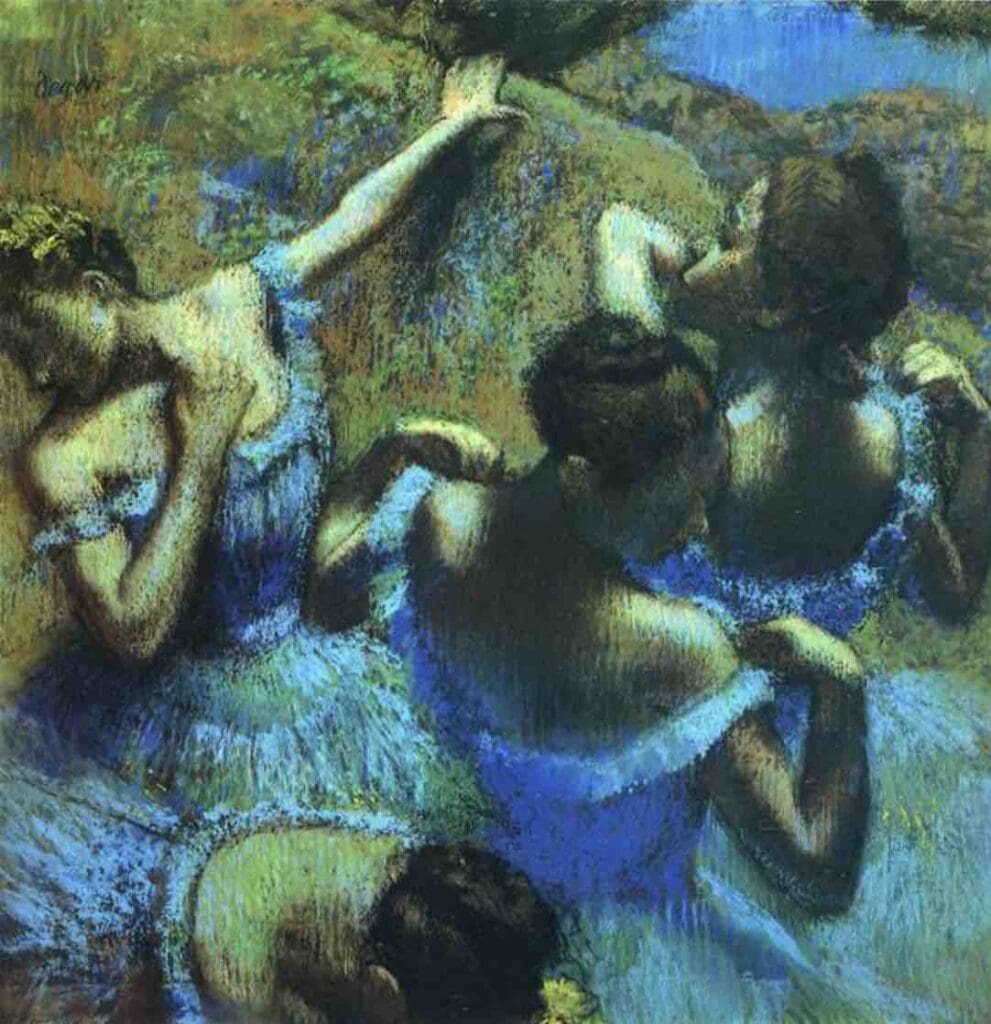
The swirling fabric and harmonious colors in this painting create a sense of motion and music, illustrating Degas’ fascination with dance.
L’Étoile (The Star) (1878)

This painting is often cited as one of Degas’ masterpieces for its graceful depiction of a dancer in a starring role, spotlighted on the stage.
Two Dancers on Stage (1874)
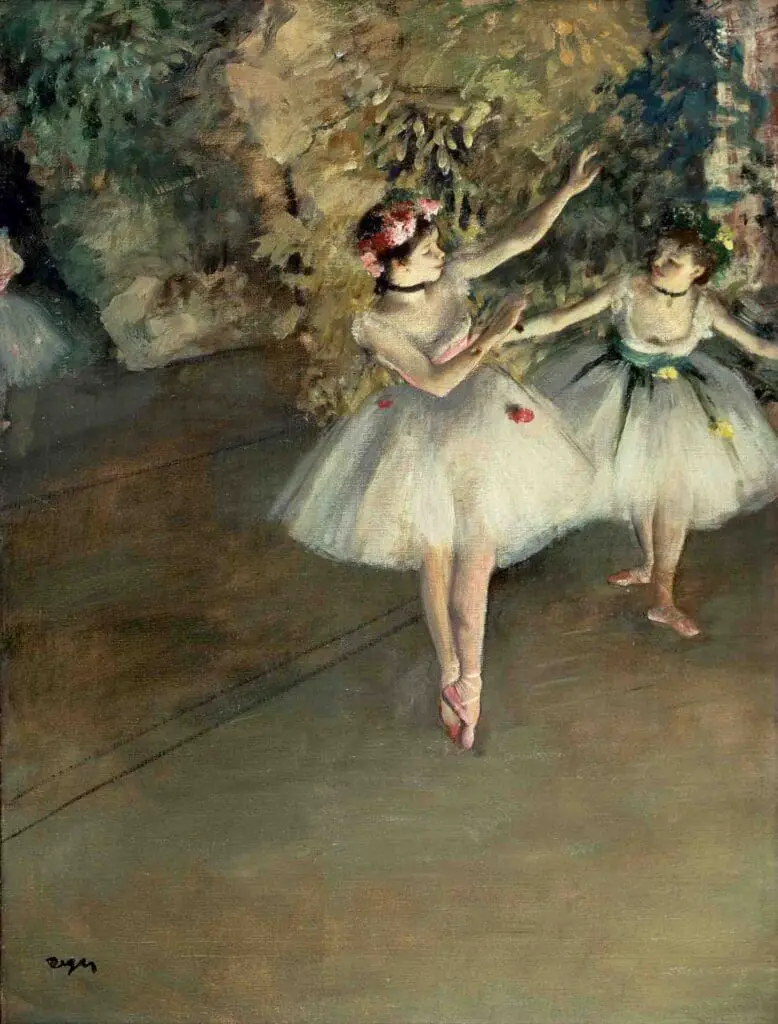
The painting captures two dancers in contrasting costumes, harmoniously sharing the stage. It’s a study of contrast and harmony.
The Absinthe Drinker (1876)
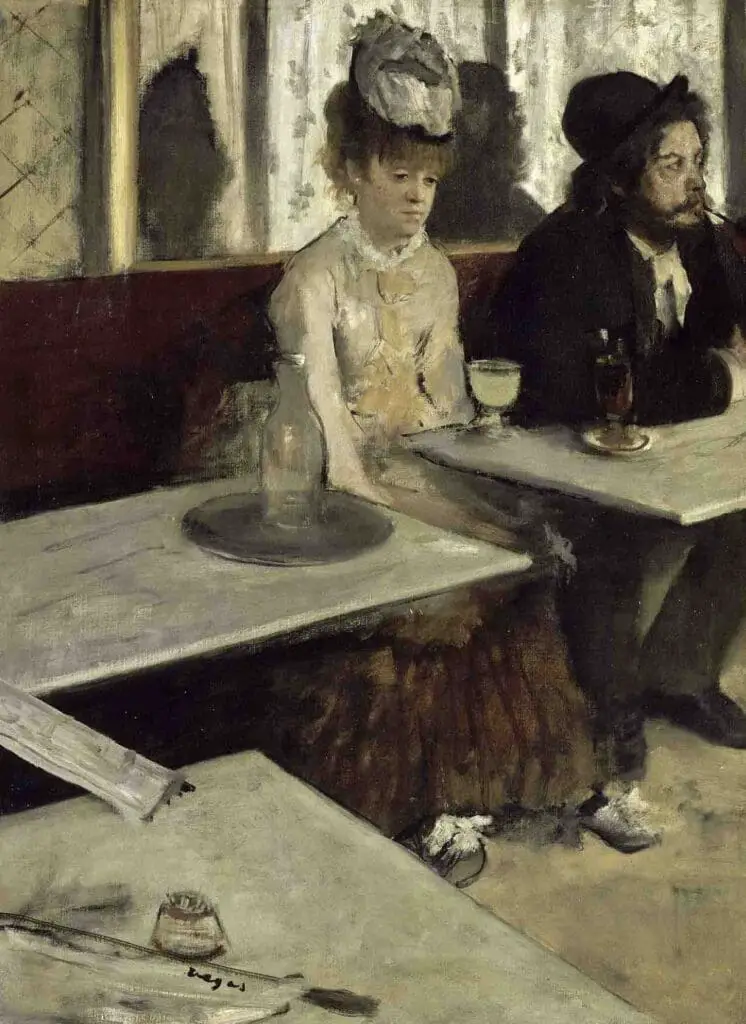
This painting presents a darker, somber mood, reflecting the alienation and despair associated with the café culture of Paris at the time.
A Cotton Office in New Orleans (1873)
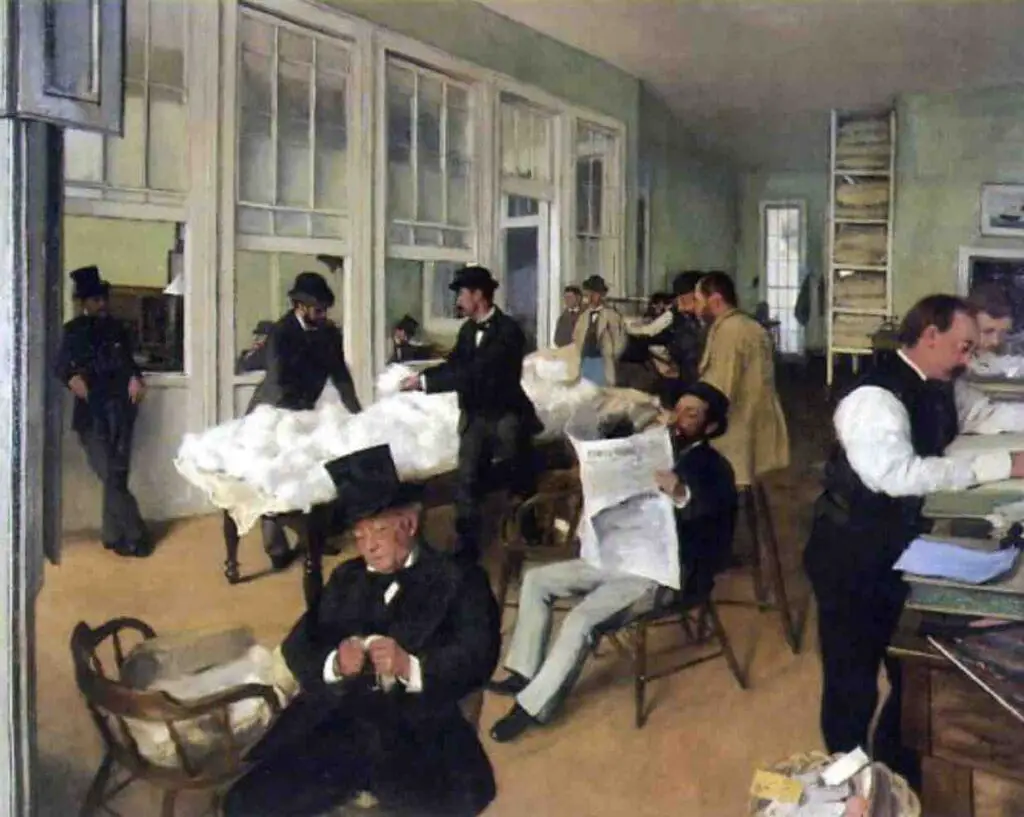
One of Degas’ few paintings is based on his visit to America, showcasing the cotton trading business. The painting is unique in its subject matter and focuses on American life.
The Dancing Class (1870)
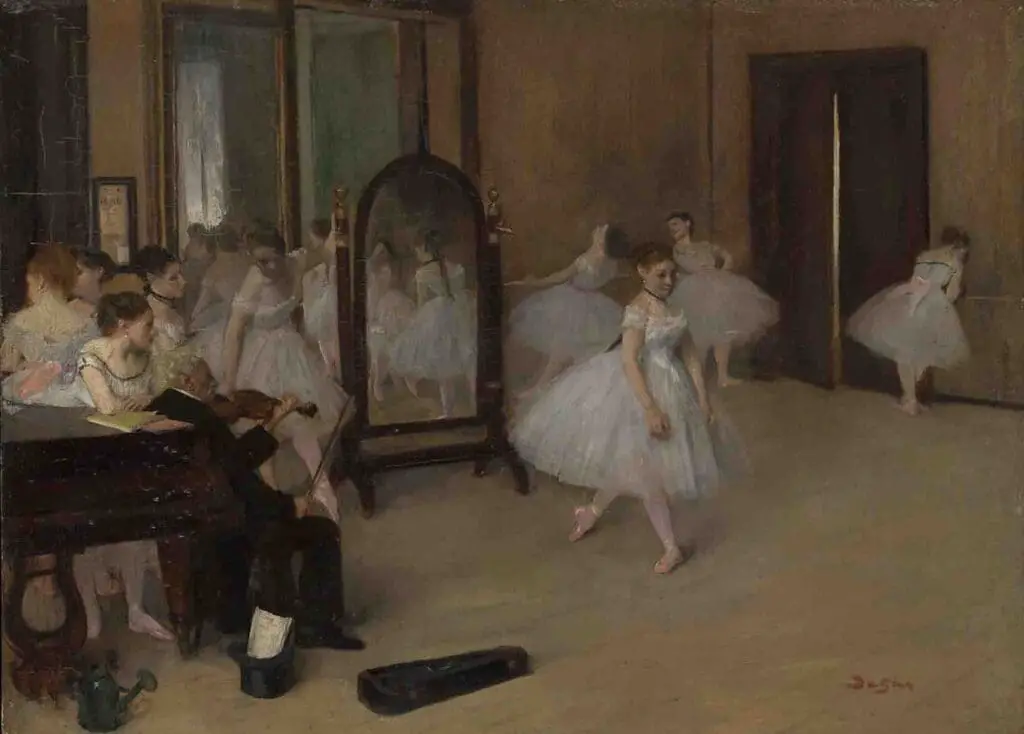
This is one of Degas’ earliest ballet paintings and introduces many motifs that would define his career: the rigorous practice, the exhaustion, and the beauty of dance.
The Bellelli Family (1858-1867)

This is one of Degas’ most ambitious early works, presenting a psychological study of his aunt, her husband, and their daughters.
The Dance Foyer at the Opera on the rue Le Peletier (1872)
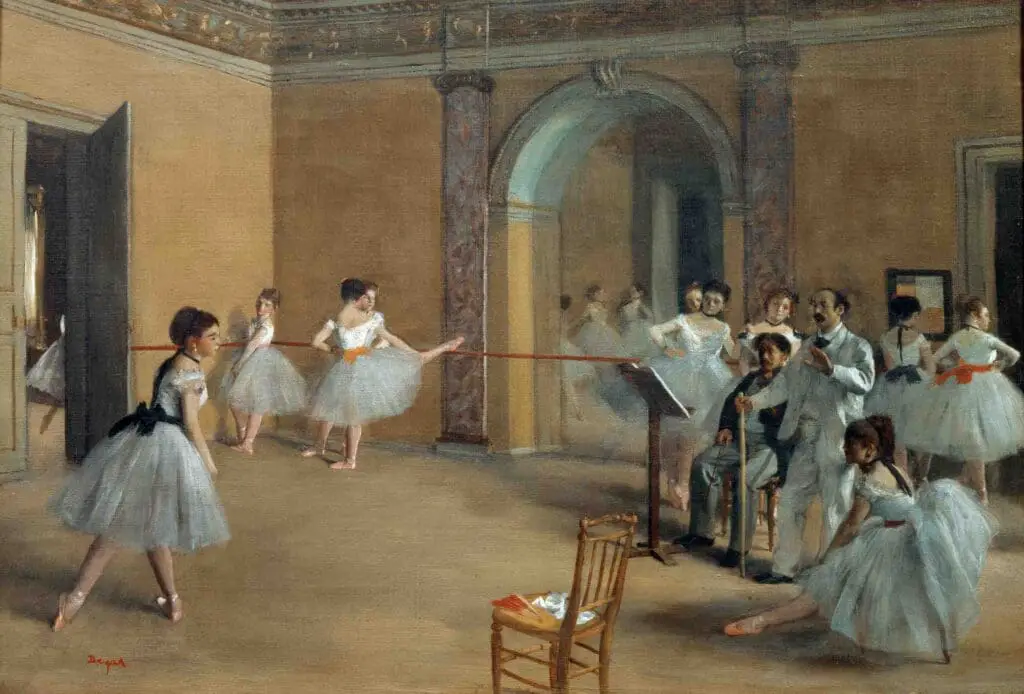
The painting captures the grandeur of the opera building while showing dancers in various stages of rest and rehearsal, highlighting the communal aspect of dance.
Woman Combing Her Hair (1888-1890)
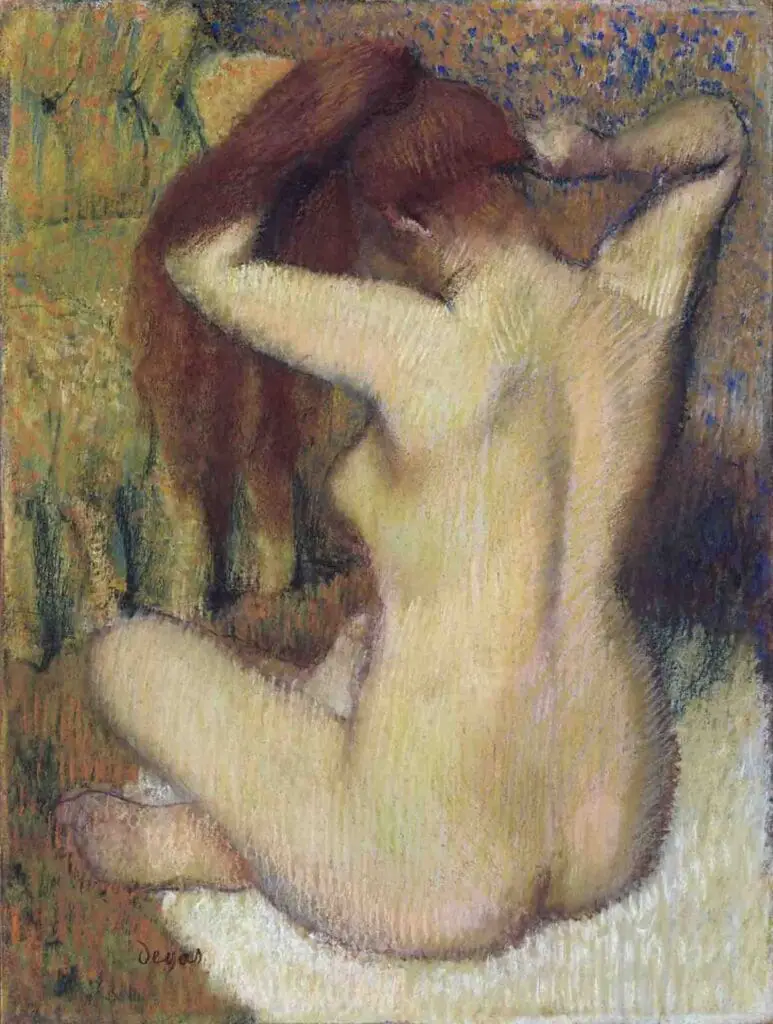
This work is another example of Degas’ intimate depictions of women in private moments, often absorbed in mundane activities. His interest lies in capturing the beauty in the ordinary.
Orchestra Musicians (1872)
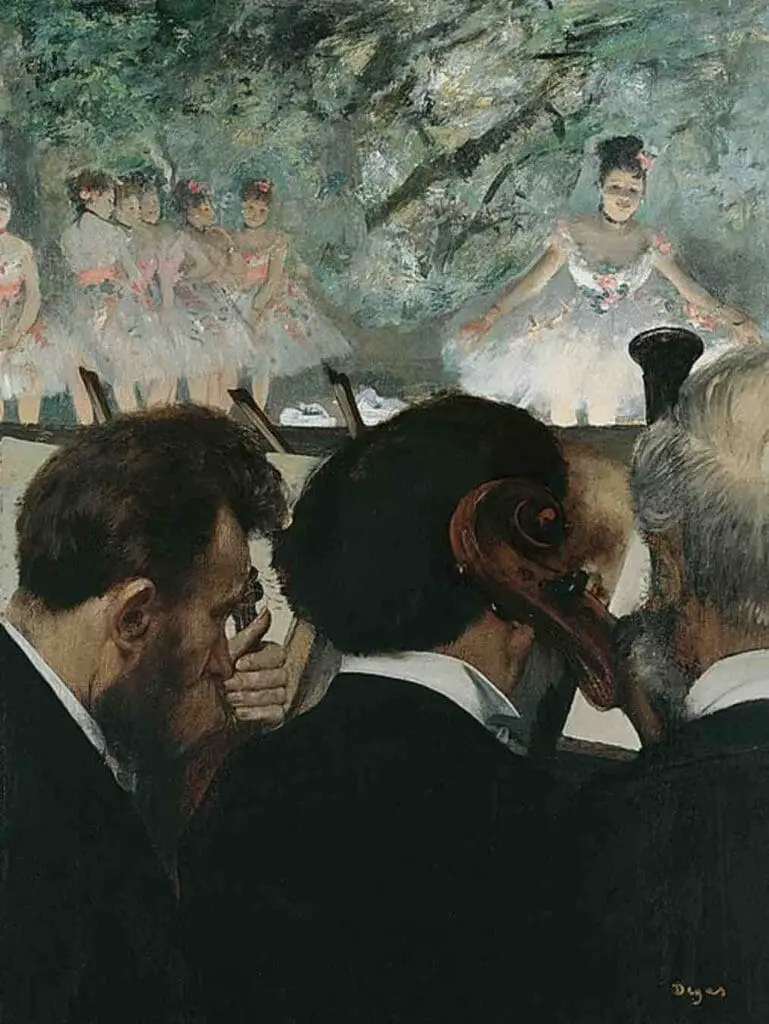
Degas moves his focus from the stage to the orchestra pit in this work, highlighting the musicians who provide the backbone to the ballet performances he so loved to paint.
Each painting by Edgar Degas is a testament to his innovative techniques, attention to detail, and ability to capture the nuances of human motion and emotion. Degas makes each setting come alive with his masterful strokes and keen observations, whether it’s a grand stage or a private room.
Anita Louise Art is dedicated to art education, great artists, and inspiring others to find and create their art. We love art that uplifts and inspires. #ArtToMakeYouSmile! #ArtToMakeYouHappy!
If you are interested to see any of my art, you can find out more by clicking here. If you are interested in what inspires me and my paintings, you can discover more by clicking here.
We have a free newsletter and would love you to be part of our community; you can subscribe to the newsletter by clicking here. I would be happy to talk to you if you have any questions. You can reach me, Anita, by clicking here.
Subscribe to our Anita Louise Art YouTube Channel with great videos and information by clicking here.
Join us for our podcast “5 Minutes With Art.” Spend just 5 minutes a week with us to discover and learn about great art and artists. You can find out more about our podcast by clicking here.
Frequently Asked Questions
What is Edgar Degas best known for in his paintings?
Edgar Degas is best known for his masterful depiction of movement, particularly in his paintings of dancers. He was a key figure in the Impressionist movement, and his innovative approach to composition and portrayal of everyday life set him apart.
Which painting is considered Edgar Degas’s masterpiece?
While opinions may vary, “The Dance Class” is often considered one of Degas’s masterpieces. This painting beautifully captures the energy and grace of ballet dancers, showcasing his skill in portraying movement.
Why did Edgar Degas focus so much on depicting dancers in his art?
Degas had a deep fascination with the world of ballet and dance. He found inspiration in the elegance and fluidity of the dancers’ movements, making them a recurring theme in his work.
Can you explain the significance of “The Absinthe Drinker” among Degas’s paintings?
In “The Absinthe Drinker,” Degas deviates from his usual ballet themes to portray a darker side of Parisian life. The painting is notable for its portrayal of social isolation and the effects of the popular drink, absinthe, in the late 19th century.
How did Degas use innovative compositional techniques in his paintings?
Degas was known for his unconventional compositions and use of dynamic angles. He often depicted scenes from unusual viewpoints, providing a fresh and modern perspective in his works.
Which painting by Degas is considered a prime example of his experimentation with pastels?
One of the prime examples of Degas’s experimentation with pastels is “After the Bath.” In this painting, he showcases his mastery in using pastel colors to create soft, delicate effects.
What role did Edgar Degas play in the Impressionist movement?
Degas was a key member of the Impressionist movement, contributing to its exhibitions and sharing its focus on capturing the fleeting effects of light and atmosphere. However, he considered himself a Realist and preferred to be known as such.
How did Degas’s artistic style evolve over the years?
Degas’s early works were more aligned with traditional painting techniques, but as he developed, he embraced experimentation. His later works show a shift towards a more modern and unconventional style.
What is the story behind “The Bellelli Family,” one of Degas’s portrait paintings?
“The Bellelli Family” is a portrait that depicts the strained relationships within Degas’s own family. It is a poignant representation of domestic tension and personal conflict.
How did Edgar Degas’s sculptures contribute to his artistic legacy?
Degas’s sculptures, particularly his bronze statuettes of dancers, are integral to his artistic legacy. They showcase his fascination with movement in three dimensions and provide a sculptural dimension to his exploration of the human form.
Related Questions
Why Paintings Like Rothko’s No. 6 (Violet, Green, & Red) Are Expensive
Mark Rothko’s No 6 (Violet, Green, and Red – 1951) was sold in 2014 for 140,000.000 Euro or over 184,000,000 USD. A huge amount for any painting. Many of Mark Rothko’s paintings continue to fetch record numbers at auction houses worldwide.
By clicking here, you can learn more by reading Why Paintings Like Rothko’s No. 6 (Violet, Green, & Red) Are Expensive.
What Makes Mark Rothko’s Paintings So Valuable?
Mark Rothko’s paintings have been valuable for many years; they are in high demand and continue to fetch record prices around the globe. At first glance, the paintings may look simple, but upon closer look, they are very complex; they are meant to evoke our emotions and transport us to another realm.
By clicking here, you can discover more by reading What Makes Mark Rothko’s Paintings So Valuable?.
The Last Painting Created By Mark Rothko Before His Death
Mark Rothko’s final painting, is a bright red painting called Untitled, 1970 that many feel symbolizes blood, particularly his blood as he died from an overdose and slashing his wrists; Mark Rothko was 66 years old and left no suicide note. We know that before his death, he also painted a black and grey series that many have felt was his painted suicide note.
By clicking here, you can learn more by reading The Last Painting Created By Mark Rothko Before His Death.

